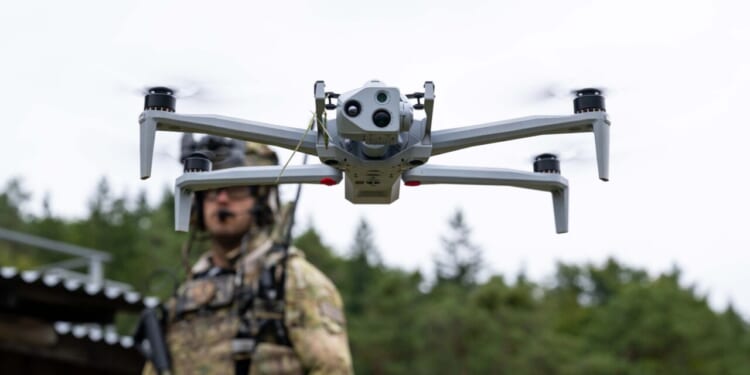The tether is an interesting and effective approach to short-range drone operations.
The United Kingdom’s Evolve Dynamics has introduced the Infinity Tether, a short-range defensive drone system designed to operate reliably in electronic warfare and GPS-denied environments. The company characterizes the Infinity Tether as being “rugged, lightweight, and intuitive.” A tethered drone can hold a fixed vantage point for more than 48 hours at adjustable altitudes up to 100 meters. The tether also serves as the drone’s power source and the data link. The Infinity Tether is fully compatible with Evolve Dynamics’ Sky Mantis 2 and Wolfe unmanned aerial systems.
The Infinity Tether’s Advantages
Such a drone’s advantages in an active electronic warfare environment are apparent. The hard-wired 100 Mbps data link ensures uninterrupted communications, making it all but impossible to jam, even with radio-denial. The same capability makes it impervious to GPS spoofing. The system is also attractive for operating in radio-silent scenarios since communications flow through the tether, providing security along with reliability.
The Infinity Tether also powers the drone’s onboard battery, providing extended deployment times while significantly reducing logistical concerns like frequently changing and maintaining large numbers of extra batteries. The Sky Mantis battery can, however, be quickly and easily replaced, and the tether is powered by direct hookup to an electric main or a field generator.
The unit is also mission-flexible. The Infinity Tether’s “Hot Drop” feature allows operators to instantly move from tethered to free-flight mode if desired. The drone can continue untethered operations for 30 minutes using the onboard battery.
Evolve Dynamics lists the total system weight, including the operator’s console, at 13.2 kilograms (29.1 lbs.). Whether that includes the drone is unclear. The Sky Mantis 2 drone weighs 8 kg (17.6 lbs.), with the Wolfe coming in at 4 kg (8.8 lbs.). Either way, the size and weight components are logistics and mobility-friendly.
The system components, including the two drone types, are either IP54 or IP55 environmentally rated, with a temperature tolerance ranging from -30 degrees to +55 degrees Celsius. The system can handle winds up to 22 miles per hour.
Projected Mission
Evolve Dynamics says the Infinity Tether system is particularly suited for modern battlefields, border security, and sensitive surveillance missions. The reliable data feed, communications, and control system, combined with extended loft time and low logistical requirements, are attractive for those roles.
The clear application to force security, whether it be airfields, base facilities, field headquarters, or outpost perimeters, is readily apparent. The ability to instantly untether the drone via the “Hot Drop” function makes the system even more valuable by allowing a contact to be investigated more closely or even pursued. This function also allows for higher altitude views, if necessary, though free flight obviously sacrifices the tether’s security and reliability advantages.
The system is clearly designed for short-range use, but drone doctrine is evolving to provide layers of security or striking power. Short-range, relatively small, and economically powered units have a clear place in that doctrine. The tethered approach, with the advantages listed above, seems like a commonsense approach to that mission.
The tether model especially lends itself to missions calling for long-term overwatch or surveillance, or operational areas requiring continuous defensive sensor coverage. The radio-silent communications are a real plus in many environments.
Unmanned Aerial Systems, or “drones,” are here to stay and will only become more ubiquitous on the battlefield and in security applications. Innovations constantly make drones more versatile and formidable. Counter-drone systems are developing at a near-equal pace, even if they are sometimes a step behind.
The Infinity Tether not only enhances the Sky Mantis 2 and Wolfe drones’ capabilities, but it also addresses common anti-drone measures, seemingly requiring a kinetic attack to effectively counter. The tether is an interesting and effective approach to short-range drone operations, reminiscent in some ways of telegraph-equipped observation balloons of the American Civil War. What is old is new again, but far more efficient.
About the Author: William Lawson
William Lawson is a military historian focusing on World War II and 20th century conflicts and the American Civil War. His specialty is operational level warfare, especially American amphibious doctrine. He writes on history, politics, and firearms for multiple publications and historical journals. He serves on the editorial advisory board for the Saber & Scroll Journal and Military History Chronicles and is a member of the Society for Military History and the American Historical Association. Lawson is based in Virginia.
Image: DVIDS.

















